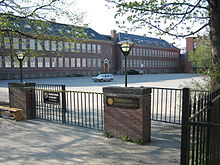Cathedral school

Cathedral schools began in the
Early schools
In the later
During and after the mission of
Subsequently, cathedral schools arose in major cities such as Chartres, Orleans, Paris, Laon, Reims or Rouen in France and Utrecht, Liege, Cologne, Metz, Speyer, Würzburg, Bamberg, Magdeburg, Hildesheim or Freising in Germany. Following in the earlier tradition, these cathedral schools primarily taught future clergy and provided literate administrators for the increasingly elaborate courts of the
Characteristics and development
Cathedral schools were mostly oriented around the academic welfare of the nobility's children. Because it was intended to train them for careers in the church, girls were excluded from the schools. Later on, many lay students who were not necessarily interested in seeking a career in the church wanted to enroll. The demand arose for schools to teach government, state, and other Church affairs. The schools, (some notable ones dating back to the eighth and ninth centuries) accepted fewer than 100 students. Pupils had to demonstrate substantial intelligence and be able to handle a demanding academic course load. Considering that books were also expensive, students were in the practice of memorizing their teachers' lectures. Cathedral schools at this time were primarily run by a group of ministers and divided into two parts: Schola minor, which was intended for younger students, would later become
The subjects taught at cathedral schools ranged from literature to mathematics. These topics were called the
Cathedral schools today
While cathedral schools are no longer a significant site of
schools. Most of those listed below are modern foundations, but a few traces their history to medieval schools.Australia
- Bathurst – Cathedral Primary School
- Bunbury – Bunbury Cathedral Grammar School
- Perth – St George's Anglican Grammar School
- Rockhampton – The Cathedral College
- Sydney – St Andrew's Cathedral School
- Sydney – St Mary's Cathedral College
- Townsville – The Cathedral School of St Anne and St James
- Wangaratta – Cathedral College
Canada
Denmark
- Ribe – Ribe Katedralskole
- Aarhus – Aarhus Katedralskole
- Aalborg – Aalborg Katedralskole
- Viborg – Viborg Katedralskole
- Odense – Odense Katedralskole
- Roskilde Katedralskole
- Haderslev – Haderslev Katedralskole
Finland
France
Guatemala
- Colegio San José de los Infantes (founded in 1781)
India
- Bangalore - Cathedral High School, Bangalore
- Lucknow - Cathedral Senior Secondary School, Hazratganj, Lucknow
- Mumbai - Cathedral and John Connon School, Fort, Mumbai
The Netherlands
Norway
- Bergen katedralskole
- Hamar katedralskole
- Kristiansand katedralskole
- Oslo katedralskole
- Stavanger katedralskole
- Trondheim katedralskole
Pakistan
- Punjab, Pakistan – Cathedral High School
South Africa
Sweden
- Linköping – Katedralskolan
- Lund – Katedralskolan
- Skara – Katedralskolan
- Uppsala – Katedralskolan
- Växjö – Katedralskolan
United Kingdom
England
- The seven King's Schools established, or re-endowed and renamed, by King Henry VIII in 1541, are located in Worcester
- London – St Paul's Cathedral School (Anglican), Westminster Abbey Choir School (Anglican), Westminster Cathedral Choir School (Roman Catholic)
- Bristol – Bristol Cathedral Choir School (a former cathedral school, it is now an academy)
- Chelmsford
- Chichester – The Prebendal School
- Chorister School
- Exeter – Exeter Cathedral School
- Hereford – Hereford Cathedral School
- Lichfield – Lichfield Cathedral School
- Lincoln, England - Lincoln Minster School
- Oxford – Christ Church Cathedral School
- Salisbury – Salisbury Cathedral School
- Southwell – The Minster School, Southwell
- Wells – Wells Cathedral School
- Winchester – The Pilgrims' School
- York – St Peter's School, York
Wales
- The Cathedral School, Llandaff
- Sixth Form)
United States
Among others:
- St. Thomas MoreCathedral School
- Boston, Massachusetts – Cathedral High School
- Charlotte Amalie, Saint Thomas, U.S. Virgin Islands – All Saints Cathedral School
- St. AugustineCathedral School
- New York, New York – The Cathedral School, on the Upper East Side
- New York, New York – The Cathedral School of St. John the Divine
- St. Vincent DePaulParish School
- Sacred Heart Cathedral School
- Washington D.C. – National Cathedral School (girls) / St. Albans School (Washington, D.C.) (boys) / Beauvoir School(elementary)
- Natchez, Mississippi - Cathedral Greenwave
See also
- List of choir schools
- Monastic school
- Carolingian Schools
- School of Chartres
- School of Reims
References
- ^ Riché 1978, pp. 126–127, 282–298.
- ^ Riché 1978, pp. 126f.
- ^ Riché 1978, pp. 282–90
- ^ Riché 1988, p. 191.
- ^ Charlemagne: "De Litteris Colendis Archived 2014-08-14 at the Wayback Machine"
- ^ Riché 1988, p. 192.
- ISBN 3-17-007522-5
- ^ C. Warren Hollister, Henry I (Yale English Monarchs), 2001 p. 25.
Sources
- NN (1999), "Domschulen", Lexikon des Mittelalters, vol. 3, Stuttgart: J.B. Metzler, p. columns 1226–1229
- Kottje, R. (1999), "Klosterschulen", Lexikon des Mittelalters, vol. 5, Stuttgart: J.B. Metzler, p. columns 1226–1228
- Riché, Pierre (1978), Education and Culture in the Barbarian West: From the Sixth through the Eighth Century, Columbia: University of South Carolina Press, ISBN 0-87249-376-8
- Riché, Pierre (1988), Daily life in the world of Charlemagne, [Philadelphia]: University of Pennsylvania Press, ISBN 0-8122-1096-4
External links
- Convent cathedral schools
- Herbermann, Charles, ed. (1913). . Catholic Encyclopedia. New York: Robert Appleton Company.
- Medieval universities
